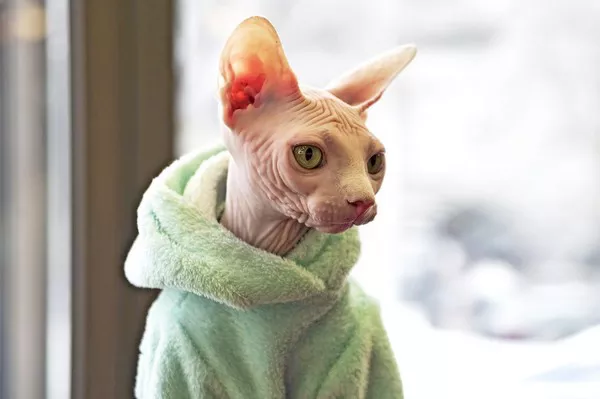The Sphynx cat, characterized by its unique hairless appearance, has long been touted as a potential solution for individuals with cat allergies. The absence of traditional fur leads many to believe that Sphynx cats are hypoallergenic or produce fewer allergens. However, the complex interplay of proteins found in cat saliva, skin, and urine challenges this assumption. In this extensive exploration, we delve into the intricate world of hypoallergenicity, decipher the distinct features of the Sphynx cat, and dispel common myths surrounding their allergy-inducing potential.
Deciphering Hypoallergenicity
The term “hypoallergenic” is often associated with substances or animals that have a reduced likelihood of causing allergic reactions. In the context of cats, this notion revolves around breeds believed to be less allergenic for individuals sensitive to typical cat allergens.
Unmasking Cat Allergens
Understanding cat allergies requires a grasp of the primary allergen—an intricate protein found in cat saliva, skin, and urine. As cats groom themselves, these allergenic proteins can become airborne, triggering allergic reactions in susceptible individuals.
The Sphynx Cat: A Breed Beyond Appearance
Contrary to popular belief, the Sphynx cat is not entirely devoid of hair. Instead, a delicate layer of downy fuzz covers its skin, offering a unique texture reminiscent of suede. While the shedding of traditional fur is minimized, Sphynx cats still produce skin cells, commonly known as dander—a prevalent allergen.
Grooming Habits
Sphynx cats exhibit meticulous grooming behaviors, involving the use of their tongues to clean their skin. This grooming routine introduces saliva onto their skin, potentially dispersing allergenic proteins and challenging the notion of hypoallergenicity.
Allergenic Realities of Sphynx Cats
Similar to their furry counterparts, Sphynx cats generate allergenic proteins in their saliva and skin. The absence of a conventional fur coat does not exempt them from producing these allergens, challenging the assumption of reduced allergenicity.
Potential Allergic Reactions
Individuals with cat allergies may still experience typical symptoms—sneezing, runny nose, itchy eyes, or skin rashes—when exposed to Sphynx cats. Allergic responses extend beyond fur, encompassing proteins present in cat saliva and skin.
Navigating Allergies in the Sphynx Cat Realm
Regular Bathing
Frequent bathing of Sphynx cats can aid in reducing the buildup of allergenic proteins on their skin. However, a delicate balance is necessary, as excessive bathing can lead to skin dryness and other dermatological concerns.
Environmental Control
Maintaining a hygienic and well-ventilated living space is crucial when cohabiting with Sphynx cats. Integrating air purifiers and implementing effective allergen control measures can contribute to minimizing allergic reactions in sensitive individuals.
Disentangling Myths: Sphynx Cats and Allergies
No Absolute Hypoallergenic Guarantee
While Sphynx cats may produce fewer allergens compared to some traditional breeds, the idea of complete hypoallergenicity is a myth. Individual responses to cat allergens are diverse, and some allergic individuals may still react to Sphynx cats.
Beyond Fur: Understanding Allergies
It is imperative to acknowledge that cat allergies extend beyond fur. Proteins present in saliva, skin, and urine play significant roles in eliciting allergic reactions, challenging the assumption that hairless equals allergen-free.
Addressing Common Misconceptions
Diet and Allergies
The role of diet in addressing cat allergies is often debated. While certain dietary modifications may benefit the overall health of the cat, there is limited evidence supporting the notion that specific diets can render a cat hypoallergenic.
Hypoallergenic Breeds
The concept of hypoallergenic cat breeds has gained popularity, with some breeds thought to produce fewer allergens. However, individual responses vary, and there is no one-size-fits-all solution for allergic individuals seeking feline companionship.
Conclusion: Informed Allergen Management for Feline Harmony
In conclusion, the perceived hypoallergenicity of Sphynx cats unravels as a complex interplay of factors. While their reduced shedding may make them a more suitable option for some individuals with cat allergies, a comprehensive understanding is essential. Sphynx cats are not entirely allergen-free, and allergic reactions may still occur. Prospective owners should spend time with the breed to assess personal tolerance before making decisions.
A Holistic Approach to Feline Companionship
Beyond addressing allergies, fostering a harmonious relationship with a Sphynx cat involves a holistic approach to care:
Regular Veterinary Check-ups
Routine veterinary check-ups are essential to monitor the overall health of Sphynx cats. Addressing any underlying health issues can contribute to their well-being.
Proper Nutrition
Providing a balanced and nutritious diet tailored to the individual needs of the Sphynx cat ensures optimal health and may contribute to skin and coat health.
Environmental Enrichment
Creating an enriched environment with engaging toys, climbing structures, and interactive play sessions contributes to the mental and physical well-being of Sphynx cats.
Social Interaction
Sphynx cats are known for their affectionate nature. Regular social interaction and bonding time with their human companions fulfill their social needs and strengthen the human-animal bond.
Informed choices, coupled with alternative measures for managing allergies and a comprehensive approach to feline care, pave the way for a harmonious coexistence with these enchanting and distinct feline companions. Ultimately, understanding and addressing the complexities of allergies and embracing the unique qualities of Sphynx cats contribute to a fulfilling and joyful feline-human partnership.











![Is the Devon Rex Hypoallergenic? [Revealed!]](https://www.catsmeowweb.com/wp-content/uploads/2023/06/Devon-Rex-cat-5.webp)













